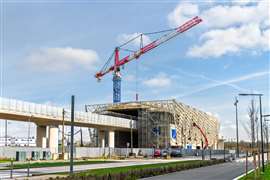Europe Regional Report: Return to (weak) growth
14 September 2011
.gif)
Economic forecasters expect the European construction market to return to growth towards the end of this year, with a more convincing expansion in 2012. But as ever, the broad regional picture hides wide disparities between different countries, and even in the stronger markets contractors say that competition is fierce.
Starting with the bad news, the southern European countries, along with Ireland, are the most distressed construction markets in the region today. A combination of high public debt before the 2008 credit crunch (Greece, Ireland, Italy and Portugal), combined with some speculation-driven bubbles in the boom years (Ireland and Spain) brought construction in these countries crashing down to earth when the recession hit.
The bursting of the bubble in residential construction in particular has had a profound effect. According to forecasting group Euroconstruct, there were 2.5 residential completions in Europe in 2007, but this year there will be less than 1.5 million. The good news is that house building returned to moderate growth in Europe this year. Scott Hazelton of IHS Global Insight says residential output will grow +1.5% this year, whereas Euroconstruct says it will be more like +5%.
But activity is in different places now. In the boom years Spain accounted for almost one third of residential construction in Europe, today it is well below 10%. According to IHS Global Insight, Germany and the UK now account for about 50% of European residential construction activity.
It is hard to understate the impact the housing collapse has had on the Spanish construction market. Whereas in 2007 the country's total construction output was about € 265 billion (US$ 380 billion), this year it will be about € 145 billion (US$ 205 billion) - a -45% drop.
In contrast, figures from the European Construction Industry Federation (FIEC) show Europe's total construction output fell from a high of € 1597 billion (US$ 2280 billion) in 2007 to
€ 1186 billion (US$ 1695 billion) this year, a -25% drop.
But even if the overall regional picture has not been as severe as what's been seen in Spain, Ireland, Greece and a other highly distressed markets, a -25% drop - equivalent to some € 400 billion (US$ 575 billion) in lost output - has been tough for the industry to absorb.
US comparison
The only region of the world where things have been harder has been the US. The construction recession there started earlier, in 2006, as residential work fell off and has construction output has been dropping ever since. Last year US the industry's output totalled US$ 788 billion, down US$ 390 billion or -34% from the US$ 1177 billion seen in the peak year of 2006.
In Europe, contractors have seen competition get tougher, margins have got tighter and there have also been some bankruptcies among mid-sized players. One such company was Rok in the UK, which went under as a result of poor financial controls in one of its division combined with a collapse in its key market of publicly-funded house building. A close competitor, social housing specialist Connaught also collapsed last year.
But with a -25% drop in the European market in just three years, perhaps the surprise has been that there have not been more bankruptcies. Most striking of all is the way that Spain's major contractors have held their ground. The annual CE-100 study of the region's largest contractors, conducted by iC's sister magazine Construction Europe (CE), showed this summer that they are at least holding their own.
The country's biggest contractors - ACS, FCC and Ferrovial were all unmoved inside the European top 10. Just outside the top ten, Acciona was stable at no. 14 and OHL moved up four from last year to no. 17. The only slip-up was Sacyr's two-place fall to no. 19.
The reason for the big players' survival seems to be their diversification. Ferrovial is a major airport operator, FCC has a big waste handling and environmental services business, Acciona is active in alternative energy, and all of them operate toll roads and benefit from an international footprint.
But European contractors have definitely felt the pinch of the recession. In 2010, the average operating margin of a CE-100 contractor was 5.01%, down from 7.19% at the peak in 2007. Revenues for the top 100 were € 379 billion (US$ 542 billion) last year, level with 2009, but down -7% from the peak of € 407 billion (US$ 582 billion) in 2008.
The drop in the CE-100's revenues has been much smaller than the -25% dive in the European construction market over the same period, and there are several reasons for this. One is that many of these big players are active outside Europe, and in sectors other than traditional contracting - operating infrastructure such as toll roads is a big area for contractors and provides a steadier revenue stream than the cyclical construction market.
Another factor is that large contractors tend to be involved in large multi-year projects that may have begun before the downturn began to bite. The final reason is that large contractors tend to have more resources, so can bid for more projects and maybe accept smaller margins during a downturn, whereas smaller companies cannot necessarily branch-out in this way.
But competition is tough, even in the more buoyant areas. The Nordic markets are among the bright spots in Europe now, but in its 2011 half-year report, Skanska, the region's largest contractor said, "Civil construction remains stable in most of our markets. The number of bidders is still large, and we can see an increased presence from international players in several of our markets, which means tight bidding margins."
The issue of competition in the European construction sector has of course been a hot topic over the last two years, following the award of a 50 km section of the A2 Motorway in Poland to Chinese Overseas Engineering Group (COVEC), part of state-woned contractor China Railway Group (CREC).
Low bid
The contractor put in an unfeasibly low bid - less than half what the Polish government had budgeted - and one of the reasons it gave for this is that it had access to state funds to mobilise the project. European contractors and their trade associations said this was unfair competition and that the Polish government was naive to accept such a low bid at face value.
But as reported in iC, COVEC was thrown off the project for non-payment of subcontractors and trying to push through a series of expensive change orders. The contracts have now been re-let to European contractors and COVEC has said it could lose as much as US$ 400 million on the scheme.
Whatever happens in this individual case, it will undoubtedly be a setback for any Chinese contractor looking for work in Europe. The A2 fiasco has been an embarrassment for the Polish roads authority - Generalna Dyrekcja Dróg Krajowych i Autostrad (GDDiKA) - and transport ministers across Europe will not rush to make the same mistakes in the future.
TEN-T
Despite the current budgetary constraints, there are at least some encouraging policy initiatives behind infrastructure development in Europe. On the regional level, the trans-European transport networks (TEN-T) project, launched in 1996 is still the main vehicle for some of Europe's most ambitious projects.
TEN-T was conceived as a way of eliminating the barriers and bottlenecks in Europe's transport network that were an inevitable result of the pre-European Union (EU) history of fragmented individual transport systems. These bottlenecks are of course often at borders, and that has meant they are often at formidable physical barriers - mountains, rivers and even seas.
A prime example is the Gotthard Base Tunnel. At 57 km it is the longest railway tunnel in the world, and its route under the Alps is a key link in the North-South TEN-T network. When operational in late 2017, it will shave almost an hour off the travel time between Zurich, Switzerland and Milan, Italy and provide a continuous high-speed rail link between northern Europe and Italy.
Another big step in the TEN-T project was taken in February when the Austrian government gave the go-ahead for work to start on the 56 km Brenner Base tunnel. With € 2.6 billion (US$ 3.7 billion) of funding in place from the Austrian government and European Commission, work is expected to run from 2011 to 2016.
Funding has always been the biggest hurdle to the TEN-T projects, with the main burden of responsibility falling on the national governments where the project resides. The European Commission puts the cost of completing all 30 projects by 2010 at € 550 billion (US$ 790 billion).
It has taken steps to help facilitate projects, like the setting up of an Executive Agency to oversee and coordinate schemes in 2006, and there are a range of funds and grants available to support TEN-T schemes. These tend to be aimed at the early feasibility study and technical evaluation phases of the schemes.
Earlier this year the Commission also brought out a White Paper discussing the future of transport in Europe. This put a strong emphasis on the rail sector, as well as inland waterways and maritime routes, for freight transport, and proposed a framework for raising the funds for infrastructure development.
Transport taxes
It advocates road fuel taxes clearly linked to CO2 and energy use, infrastructure charging, particularly for the heavy vehicles that do most damage to roads, and the earmarking of revenues from these taxes for future infrastructure development. In simple terms it is a 'user pays' and 'polluter pays' policy.
It remains to be seen how much of the White Paper turns into pan-European laws or is adopted at a national level. Perhaps one good thing to come out of the recession and the approach of using stimulus spending during the worst years is that the idea of investing in infrastructure now seems to be gaining favour in Europe. In previous years environmental concerns seemed to be tipping the balance the other way.
But the biggest challenge for Europe will be finding the money. As in the US, there is a broad political consensus that infrastructure investment is needed to maintain and boost economic competitiveness, the problem at the moment - in both regions - is finding the money to do it.
But the key unanswerable question for the industry at the moment is whether the current sovereign debt crisis will push the region back into recession, and if it does, how bad will it be?
STAY CONNECTED



Receive the information you need when you need it through our world-leading magazines, newsletters and daily briefings.
CONNECT WITH THE TEAM










